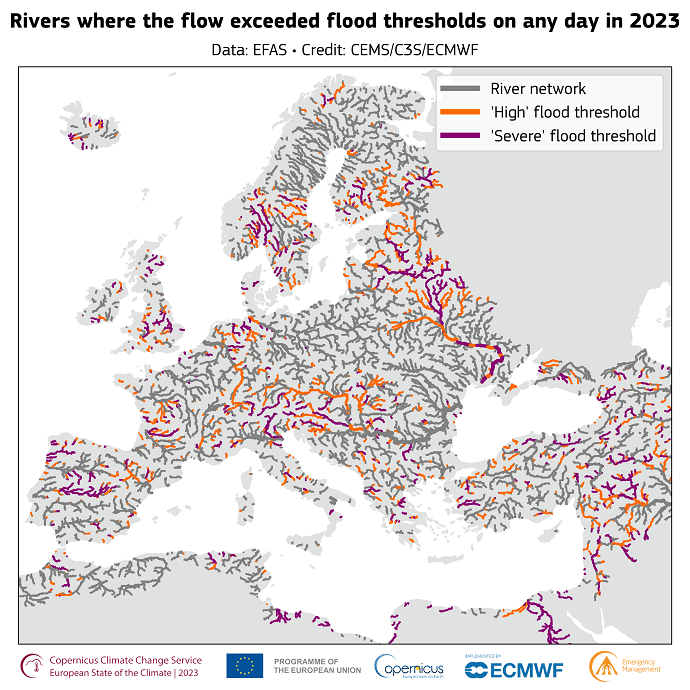Know Your Flood Zone: Don't Let Flood Risk Sweep Away Your Business. Get Assessed & Protect Your Investment

The Alarming Rise of River Floods in Europe
Across Europe, picturesque riverside towns and bustling metropolises alike are facing a growing threat: river floods. The last few years have painted a worrying picture, with devastating floods striking across the continent. In 2021, Germany saw its worst floods in decades, claiming dozens of lives (1). Following this, in 2023, heavy storms across Italy caused numerous rivers to overflow their banks, leading to landslides and submerging entire villages (2). A third of Europe's rivers exceeded 'high' flood levels, with 16% reaching 'severe' thresholds (see the map below) (3). Major waterways like the Loire, Rhine, and Danube saw record or near-record highs due to storms in the last few months of the year. These are just a handful of stark examples of a growing trend.

This map shows European rivers that experienced high or severe flooding in 2023. Grey lines indicate major rivers (drainage area exceeding 1,000 km²). Orange sections represent rivers exceeding the "high" flood level (occurring on average every 5 years), while purple sections signify those exceeding the "severe" level (occurring on average every 20 years).Data source: EFAS. Credit: CEMS/C3S/ECMWF.
The Science Behind this Surge
Rising global temperatures, fuelled by human activity, are leading to more intense rainstorms, causing rivers to overflow their banks with greater frequency and ferocity [4]. The problem is compounded by severe droughts preceding these storms, as well as melting glaciers contributing to higher water levels in rivers, further increasing flood risk [5].
Beyond the Headlines: The Hidden Costs of Floods
The devastation of floods goes beyond the tragic human cost. Businesses face a financial ripple effect, experiencing direct losses from damaged property and lost inventory to disrupted operations and long-term reputational damage. Flooded infrastructure disrupts day-to-day activities, lost inventory impacts sales, and rebuilding costs can cripple a company's financial health. A recent study estimates that without preventative measures, river floods could cost Europe a staggering €24 billion annually by 2050 [6]. Furthermore, floods caused a staggering 81% of economic losses due to climate impacts in 2023, affecting an estimated 1.6 million people [6].
Staying ahead of the Flood: The Power of Proactive Risk Assessment
In the face of this growing threat, proactive flood risk assessment is no longer a luxury; it's a necessity. This involves analyzing historical data, flood modeling, and using advanced geospatial technologies to identify areas most susceptible to flooding. This is where refinq comes in.
Introducing Refinq: Your Partner in Flood Resilience
We specialize in creating hyper-local flood risk assessments for businesses. Our assessments go beyond generic ratings, providing the following benefits:
- Hyper-local precision: Get beyond generic flood zones. We use high-resolution flood data and cutting-edge risk models to deliver detailed information specific to your exact asset location. This empowers you to make informed decisions to protect your investments.
- Future-Proofed Planning: Prepare for the coming decades with assessments that consider the impact of climate change. Our assessments incorporate not only historical flood data and flood modeling, but also future climate projections, Intergovernmental Panel on Climate Change **(**IPCC) Representative Concentration Pathways (RCPs) climate projections extending upto to 2100, preparing you for potential flood risks for years to come.
- Data-Driven Decision Making: Our assessments are grounded in robust datasets, including historical flood information, advanced flood modelling, and real-time location data. This ensures you have the most accurate information possible to make critical choices.
Building a Flood-Resilient Future, Together
The fate of European businesses and their attendant communities is tied to how we manage river floods. By proactively assessing flood risk, businesses can take charge of their future. With smart planning, solid flood prevention measures, and financial readiness, we can make Europe more flood-proof, one business at a time.
Don't wait for disaster to strike. Take charge of your flood risk today. Contact our experts for a personalized flood assessment and prepare for whatever comes your way.
References:
Cover Image: Yogendra Singh on Pexels